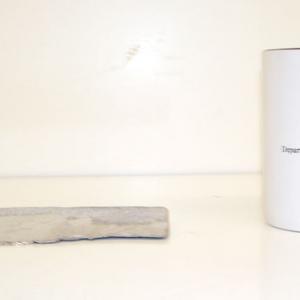College of Liberal Arts & Sciences
4C20.99 - Wood's or Field's Metal - Liquid Metal Alloys
Wood's or Field's metal are low temperature melting point metal alloys. Typically they are formulated to melt at temperatures between 130 and 212 degrees Fahrenheit or 55 to 100 degrees Celsius. So, if they are made into the shape of a spoon or a stirring rod, they will melt when used to stir a hot cup of coffee, tea, or water.
The typical Wood's metal contains 50% Bismuth, 27.5% Lead, 13.3% Tin, and 10% Cadmium.
The "Galinstan" is a liquid metal alloy made from Gallium, Indium, and Tin, which has a melting point of 10 degrees Celsius or 51 degrees Fahrenheit. This means that you can put it into the refriderator and "freeze" it to any shape you wish but once you take it out and place it into your hand or let it warm up to room temperature it will return to a liquid.
- Michael D. Dickey, "Liquid Metals At Room Temperature", Physics Today, Vol. 74, #4, April 2021, p. 30.
- "Gag with a Spoon", Popular Science, Vol. 27, #2, Feb. 2005, p. 84.
- Simon Quellen Field, "A Metal That Melts in Hot Water", Gonzo Gizmos, p. 164.
Disclaimer: These demonstrations are provided only for illustrative use by persons affiliated with The University of Iowa and only under the direction of a trained instructor or physicist. The University of Iowa is not responsible for demonstrations performed by those using their own equipment or who choose to use this reference material for their own purpose. The demonstrations included here are within the public domain and can be found in materials contained in libraries, bookstores, and through electronic sources. Performing all or any portion of any of these demonstrations, with or without revisions not depicted here entails inherent risks. These risks include, without limitation, bodily injury (and possibly death), including risks to health that may be temporary or permanent and that may exacerbate a pre-existing medical condition; and property loss or damage. Anyone performing any part of these demonstrations, even with revisions, knowingly and voluntarily assumes all risks associated with them.
